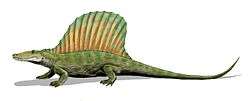Sphenacodontia
| Sphenacodonts Temporal range: Pennsylvanian-Recent, 299.9–0 Ma | |
|---|---|
 | |
| Pantelosaurus | |
| Scientific classification | |
| Kingdom: | Animalia |
| Phylum: | Chordata |
| Clade: | Synapsida |
| Clade: | Eupelycosauria |
| Clade: | Sphenacodontia |
| Genera and Clades | |
Sphenacodontia is a stem-based clade of derived synapsids. It was defined by Amson and Laurin (2011) as "the largest clade that includes Haptodus baylei, Haptodus garnettensis and Sphenacodon ferox, but not Edaphosaurus pogonias".[1] They first appear during the Late Pennsylvanian epoch.
Basal Sphenacodontia constitute a transitional evolutionary series from early pelycosaurs to ancestral therapsids (which in turn were the ancestors of more advanced forms and finally the mammals). One might say that the Sphenacodontians are proto-therapsids.
Characteristics
The defining characteristics include a thickening of the maxilla visible on its internal surface, above the large front (caniniform) teeth; and the premaxillary teeth being set in deep sockets. All other (sister group and more primitive) synapsid clades have teeth that are set in shallow sockets.
Classification


The following taxonomy follows Fröbisch et al. (2011) and Benson (in press) unless otherwise noted.[1][2]
Class Synapsida
- Eupelycosauria
- Sphenacodontia
See also
References
- 1 2 Benson, R.J. (2012). "Interrelationships of basal synapsids: cranial and postcranial morphological partitions suggest different topologies". Journal of Systematic Paleontology. in press. doi:10.1080/14772019.2011.631042.
- ↑ Jörg Fröbisch, Rainer R. Schoch, Johannes Müller, Thomas Schindler and Dieter Schweiss (2011). "A new basal sphenacodontid synapsid from the Late Carboniferous of the Saar-Nahe Basin, Germany" (PDF). Acta Palaeontologica Polonica. 56 (1): 113–120. doi:10.4202/app.2010.0039.
- Laurin, M. and Reisz, R. R., 1997, Autapomorphies of the main clades of synapsids - Tree of Life Web Project
